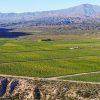In 2011, the second Thursday of November was designated International Tempranillo Day. Of course, it’s a celebration in which Spanish wines occupy the lion’s share of the spotlight but the grape is also grown elsewhere in the world, not least in Argentina.
In fact, the largest producer in South America has a long history growing the grape with several labels representing landmarks in the country’s wine producing history.
Tempranillo in Argentina
Across the world 231,000 hectares are under vine with Tempranillo, of which 88% are located in Spain. The remaining vineyards work their charms in Portugal, Australia, South Africa, the USA, Argentina and several other countries.
‘Tempranillo was introduced to Argentina in the 19th century and expanded enormously. Historically it has been one of the most common grapes found thanks to its natural productivity. However, when in the 90s the country committed to a more quality-focused path it was overlooked, perhaps because it was associated with low quality, mass-market producers. When handled properly, however, it can display its full oenological potential and produce extremely good wines,’ says Sebastián Zuccardi who makes Q Tempranillo. The family winery started making it in 1997 when it purchased some old parcels in Santa Rosa, an oasis in eastern Mendoza, and today it is considered the first high end Argentine Tempranillo.
The popularity of Tempranillo in Mendozan vineyards described by Zuccardi was due in great part to the thousands of Spanish immigrants who immigrated to Argentina at the end of the 19th and beginning of the 20th centuries. Given the Spanish influence on the country’s culture in general, it’s hardly surprising that the wine became a local favourite.
Argentine Tempranillo has also found a market overseas. Rodolfo Sadler, Winemaker at La Mascota, which produces one of the best local examples, remembers: ‘In the early 90s, the first importers who arrived looking for Argentine wine weren’t thinking about Malbec at all, they were interested in grapes that European consumers were already familiar with. So Tempranillo became an option for us alongside Malbec. We started exporting Tempranillos first, then Tempranillo-Malbec blends, which gave Malbec its chance. Today, we still sell Tempranillo to certain markets in Europe.’
According to the National Institute of Viticulture, in 2019 Argentina had 5562 hectares of Tempranillo under vine distributed mainly across Mendoza (5295) and to a lesser extent in San Juan (169), La Rioja (52), Catamarca (19) Río Negro (11) and Salta (9), with 7 more found in smaller vineyards elsewhere.
What to expect from an Argentine Tempranillo
Tempranillo is a versatile variety that is very popular for the range of styles it has to offer, from profound reds to intriguing rosés similar to what you find in several different areas in Spain.
Young Tempranillos tend to be full of red fruit and gentle on the palate, while those aged in wood grow medium bodied with sweet, spicy notes. However, it was the great wines from Rioja and Ribera del Duero that established its reputation as an elite wine suitable for cellar ageing and so it is often made into intense reds with good concentration and optimal ageing potential.
Having initially been favoured for its high yields and to lend colour and tannins to table wines, today it is enjoying a revival at the hands of oenologists who know how to bring out the best in the grape such as Karim Mussi from Bodega Alto Cedro. ‘In LaConsulta (Uco Valley) it’s the second most widespread variety after Malbec thanks to its historical popularity. There are a lot of old vines, some of them even pre-phylloxera, planted directly and grown in arbours. It’s a very productive grape but in the soils in this area it tends to be far less vigorous, yielding tightly packed bunches of small grapes with good fruit and concentration.’ Mussi makes Año Cero Tempranillo and also uses it in his high end blends.
Other interesting examples can also be found in the south of the Uco Valley, in La Consulta and El Cepillo, such as Crux de Bodega Alfa Crux and Contador de Estrellas Tempranillo Eterno, from Absurdo Wines. An oddity is El Relator Tempranillo, made with grapes from Tupungato, one of the coolest and highest areas of the Uco Valley, resulting in a vibrant, silky wine.
Further south still, in San Rafael, we find one of the most elegant and potent Tempranillos around, Alfredo Roca Reserva de Familia.
Meanwhile, Maipú and Luján de Cuyo, where most hectares of Tempranillo are located, are the homes of Tempus Alba, La Gran Mascota made by Rodolfo Sadler, Mendel Lunta by Roberto de la Mota and Zuccardi Q, wines that after lengthy ageing in barrels offer a classic, serious-minded profile ideal for bottle ageing.
Once again, the forgotten history of the Argentine wine industry has come to the fore, this time in relation to one of the most popular varieties in the world, which has definitively found its place in high altitude vineyards.



